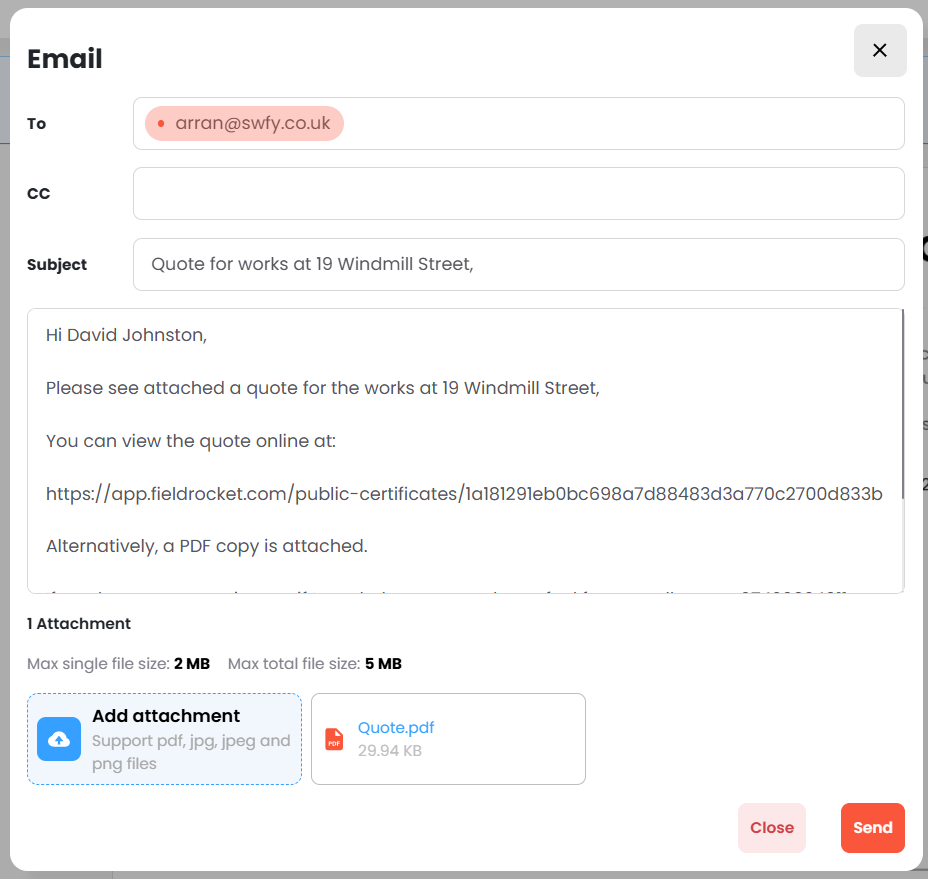How to Price a Job in the UK as a Contractor or Tradesperson

Pricing a job accurately is one of the most important skills a UK tradesperson can master. Charge too much and you’ll lose work to competitors. Charge too little and you’re effectively undervaluing your work and your time.
This is a problem because, without an accurate pricing formula, most people tend to undervalue their work, work long hours, and make little to no profit.
In this guide, we’ll show you how to break down the process, understand your costs, and put together fair prices for both you andyour customers.
Why Accurate Pricing Is Crucial
Getting your pricing right is about more than just numbers; it’s about the health and sustainability of your business. Here’s why accurate pricing matters for tradespeople like you:
- Improved Cash Flow: Pricing each job properly ensures you’re paid what you need to cover all costs and maintain steady cash flow.
- Customer Trust: It isn’t just about setting a profitable price. Knowing your margins and being transparent with pricing builds trust and credibility with clients, making them more likely to recommend or rehire you.
Consistent Profitability: Factoring in every expense, along with a realistic profit margin, helps prevent financial headaches down the line.

Above: A quote created with FieldRocket with individual line items and transparent pricing.
Pricing Basics: What Goes Into Pricing a Job?
To price a job effectively, you’ll need to account for four key components:
01. Labour costs
02. Material costs
03. Overheads
04. Profit.
Each is equally important to your final number, and can take a bit of time to fine-tune.
Here are some other best practises when learning how to price a job:
1. Follow a Pricing Strategy
- Use flat rates for small, predictable jobs.
- Opt for hourly rates for complex projects with uncertainty.
- Consistency builds trust, so try to standardise rates for common tasks.
2. Research Competitor Rates
Stay informed about industry standards without undervaluing your skills. Remember, the cheapest providers rarely win on quality.
3. Standardise Pricing With Templates
You can save time by creating a price list for frequent tasks. This is especially helpful if you have a team and want to delegate pricing for some jobs.
We recommend using job management software like FieldRocket to save specific line item templates for job components. For example, a heating & plumbing company might save line item templates for a routine gas safety service, a tap replacement, or a power flushing
How to Price a Job: Step-by-Step Guide
Step 1: Assess the Job and Scope
Visit the site if possible (and necessary) and gather all the information you need upfront. Ask yourself:
- Are there site access issues or unique challenges?
- Is additional prep work needed, like preparing surfaces or fixing poor prior work?
Take photos, estimate how long the job will take, and list required tasks.
Step 2: Calculate Labour Costs
Labour costs represent the time and effort required to get the job done. The best way to calculate labour costs is to have an hourly rate, and simply multiply that figure by how long the job will take.
Now then, to calculate a basic but accurate hourly rate:
- Add up allyour labour-related expenses, including wages, taxes, and benefits.
- Work out how many billable hours you have in a year (after accounting for admin time, holidays, and driving).
- Divide the two to get an hourly rate that onlyconsiders billable hours.
Next, you’ll need to estimate the time taken for a job:
- Track how long it takes you to complete individual tasks
- Use these times as ‘building blocks’ for larger jobs by breaking them down
- Cross-check your prices with your competitors rates
Example Calculation
Let’s say your annual labour-related costs are £60,000, and you work 1,500 billable hours in a year. Your baseline rate would be £40/hour. Adding a desired profit margin of 30%, your hourly rate becomes £52.
Then, if a job takes you 2.5 hours, simply multiply £52 x 2.5 to get £130.
Step 3: Add Material Costs
Be precise about materials by listing all required items for the job, from nails to paint to major fittings.
- Get material quotes from suppliers ahead of time.
- Add a small markup (typically 10-20%) to cover your handling and transport time.
- To manage price fluctuations, include a clause in quotes that states the price may vary if material costs rise. Alternatively, you can add a validity period to the quote.
Example
- Copper pipe (3m): £15
- Boiler: £1100
- Fixings and clamps: £10
- Markup (15%): £168.75
Total Material Cost= £1293.75
Pro Tip
Use a spreadsheet or quoting software to track material costs and streamline this step.
Step 4: Factor in Overheads
Overheads include expenses like van maintenance, tools, software subscriptions, and insurance. These are not directly tied to any single job but should be spread across all your work.
Example Calculation
If your monthly overheads are £2,500 and you work 120 billable hours a month, each hour should carry £20.83 of overhead costs.
Step 5: Add Your Profit Margin
Profit is what keeps your business healthy. It’s also your reward for running a business instead of being employed.
Typical profit margins for UK trades range from 15% to 30%, depending on the type of job and market conditions.
Once you’ve calculated all your costs, simply add your profit margin percentage on to get a final cost.
Ultimately, you need to decide what profit margin you’re happy with and what you can comfortably charge customers. Different pricing strategies can mean that your profits go up or down in relation to other benefits (such as growing your customer base quickly).
Profit Margin Example (20%)
Total Costs (Labour + Materials + Overheads) = £135.40 + £28.75 + £60 = £224.15.
Profit Margin (20%) = £224.15 x 0.20 = £44.83.
Job Price = £224.15 + £44.83 = £268.98.
(Bonus) Step 6: Present a Clear and Professional Quote
Turn these numbers into a professional-looking quote with itemised costs, terms, and validity periods. Here’s how:
01. Use quoting software like FieldRocket to build the quote
02. Break down the job cost for your customer using line items
03. Add a charge for your labour, overheads, and profit. This can be bundled together.

Overcoming Common Pricing Challenges
- Unexpected Material Cost Rises
Include contingencies in quotes and validity periods to protect your bottom line.
- Client Negotiation
Make your value clear with itemised quotes. Highlight expertise, guarantees, and customer testimonials to justify pricing.
- Misestimated Labour Time
Review past quotes regularly and adjust time estimates based on experience.
Simplify Your Workflow with FieldRocket
Accurate pricing and professional quoting don’t have to be time-consuming. With FieldRocket, you can:
- Generate quotes in minutes with pre-set templates.
- Create all industry certificates on our mobile app
- Keep track of all customer quotes and jobs in one place.
Take the guesswork out of pricing and quoting. Sign Up for Free today and see how FieldRocket makes job management effortless.
Create, sign, and send all your industry certificates with FieldRocket
Looking for a way to simplify your paperwork? FieldRocket offers customisable, professional & paperless certificates and forms for all trades.
Get started with a 7-day free trial by clicking below.

